It looks like you're using an Ad Blocker.
Please white-list or disable AboveTopSecret.com in your ad-blocking tool.
Thank you.
Some features of ATS will be disabled while you continue to use an ad-blocker.
share:
a reply to: Soylent Green Is People
The fact that the details of the moon are big enough to be recognisable as opposed the moon being so small that I can't, is not caused by an optical illusion, obviously.
It is either big enough for human eyes to see or it isn't.
Brightness and contrast are a factor but it doesn't help you see something that is too small to see.
What you are suggesting is that our brain somewhow magnifies objects in the center of our view more than it does for the rest of our field of view? We all know that is not true.
Well, as I said above, I think some of it (the apparent large size in the horizon) is an illusion, but some of it could be the contrast/brightness. I wouldn't say it "obviously is not an illusion".
The fact that the details of the moon are big enough to be recognisable as opposed the moon being so small that I can't, is not caused by an optical illusion, obviously.
It is either big enough for human eyes to see or it isn't.
Brightness and contrast are a factor but it doesn't help you see something that is too small to see.
First of all, it is a fact that the Moon appears smaller in a photo I take with my mobile phone than I think it should look -- i.e., it seemed bigger in person than in the photo. I'm sure I'm not the only person who notices that illusion about pictures taken with a standard camera and lens. I think that is at least partially due to our eyes being able to "see" a wide angle scene, but our brains really concentrate on the center of the scene more than the periphery. The camera, on the other hand, picks up the entire scene in front of me under the same "level of perception" -- because the camera generally perceives the periphery of the image it is taking the same way it perceives the center of that image, and presents the entire scene in a single homogenously-perceived image.
What you are suggesting is that our brain somewhow magnifies objects in the center of our view more than it does for the rest of our field of view? We all know that is not true.
edit on 5-5-2017 by PlasticDreams because: (no reason given)
a reply to: Soylent Green Is People
This is not the point that I was making, this illusion does not create a difference in the amount of detail that can be seen, since the whole premise is that the size doesn't actually change.
When the Moon looks huge on the horizon but looks smaller when it is high in the sky, that is due mostly to optical illusions. There is still some question as to exactly what illusion is the cause, but you yourself can verify that it is ONLY and illusion (and that the Moon is not actually larger on the horizon than it is in the sky) with a simple experiment: the next time the Moon looks huge on the horizon, take a ruler or measuring stick and hold it at arm's length in front of you and measure the apparent diameter of the moon. Second, wait a few hours until the Moon is more over your head (and probably looing smaller), and measure it again using the same technique....
This is not the point that I was making, this illusion does not create a difference in the amount of detail that can be seen, since the whole premise is that the size doesn't actually change.
originally posted by: PlasticDreams
a reply to: Soylent Green Is People
What you are suggesting is that our brain somewhow magnifies objects in the center of our view more than it does for the rest of our field of view? We all know that is not true.
Not "magnify" per se, but our brains can fool us with how we perceive things.
What our brains tell us that we see is not the same as what ours eyes actually do see, such as with the Ebbinghaus illusion I posted earlier.
I mean, we all have noticed that a picture of the Moon taken with a standard camera or standard mobile phone is disappointingly smaller than what the moon looked to our eyes when the picture was taken. It's a real thing.
originally posted by: PlasticDreams
a reply to: Soylent Green Is People
This is not the point that I was making, this illusion does not create a difference in the amount of detail that can be seen, since the whole premise is that the size doesn't actually change.
Yes, I understand. And that's why I said some of that could be due to differences in contrast, rather than being an optical illusion.
Another reason could be that when there is a half-moon visible, the sunlight is shining across it, making some of the craters stand out due to shadowing. However, when the moon is full, the light is more direct, and there is less shadowing to accentuate the craters.
edit on 5/5/2017 by Soylent Green Is People because: (no reason given)
originally posted by: Soylent Green Is People
Yes, I understand. And that's why I said some of that could be due to differences in contrast, rather than being an optical illusion.
^This.
I've just got back from the supermarket and hanging in the early evening blue sky is a beautiful half moon with lots of detail visible. In a few hours the moon will be much much brighter relative to the background and those details will be much more difficult to see.
edit on 5/5/2017 by
OneBigMonkeyToo because: (no reason given)
a reply to: Soylent Green Is People
Your first pic has an higher zoom than our eyes but it shows the moon being too small for us to be able to see any detail on it. And now you are suggesting our brains create an "illusion" that would somehow magnify the moon in reality? You may say "not magnify per se" but that is what you are saying and it is nonsense. A lens magnifies things, not our brain.
You also show pics of higher zoom that show it like I sometimes see it with my own eyes. I have seen it in different sizes with my own eyes, sometimes big enough to see the details, sometimes too small to see any detail, kinda like your first 3 pics show, only with the same focal length of my eyes.
It has nothing to do with an illusion that makes it appear bigger in relation to the surroundings.
What is the focal length of your second pic?
And I told you why this doesn't fly.
Not "magnify" per se, but our brains can fool us with how we perceive things. What our brains tell us that we see is not the same as what ours eyes actually do see, such as with the Ebbinghaus illusion I posted earlier.
Your first pic has an higher zoom than our eyes but it shows the moon being too small for us to be able to see any detail on it. And now you are suggesting our brains create an "illusion" that would somehow magnify the moon in reality? You may say "not magnify per se" but that is what you are saying and it is nonsense. A lens magnifies things, not our brain.
You also show pics of higher zoom that show it like I sometimes see it with my own eyes. I have seen it in different sizes with my own eyes, sometimes big enough to see the details, sometimes too small to see any detail, kinda like your first 3 pics show, only with the same focal length of my eyes.
It has nothing to do with an illusion that makes it appear bigger in relation to the surroundings.
What is the focal length of your second pic?
Yes, I understand. And that's why I said some of that could be due to differences in contrast, rather than being an optical illusion.
And I told you why this doesn't fly.
edit on 5-5-2017 by PlasticDreams because: (no reason given)
originally posted by: PlasticDreams
a reply to: Soylent Green Is People
It has nothing to do with an illusion that makes it appear bigger in relation to the surroundings.
The illusion is in fact real, because I have done what I suggested you do. I measured the "Huge-Looking" Moon on the horizon with a ruler held at arm's length in front of me, and then I measured it again several hours later when it was high in the sky and looking much smaller.
The measured sized turned out to be the same for both, so the answer is that my brain (for some reason) was making the Moon look much larger on the horizon than when it was in the sky. Therefore, if the size of the Moon didn't change , then some optical illusion in which my brain plays tricks on me is involved in that phenomenon.
What is the focal length of your second pic?
I don't know. It was a stock image from the internet with no details.
All I know is that that objects in pictures can look larger or smaller depending on the focal length (and image format size) used, and that is why Earth could look to be different sizes in images taken by Apollo astronauts (due to the Hasselblad cameras they used having a 60 mm lens and a 250 mm lens).
And I told you why this doesn't fly.
OK. I tired to come up with a hypothesis -- one in fact I have noticed myself (i.e., seeing more Moon detail against the sky at dusk rather than against a black sky). However, that seems to be not your experience.
So what is your hypothesis as to why you see more detail sometimes as opposed to other times?
edit on 5/5/2017 by Soylent Green Is People because: (no reason given)
a reply to: PlasticDreams
It never shows no detail for a start, the Moon is sometimes closer hence super Moons . When low on the horizon it looks larger as it can be compared to objects in the fore grouns. Take a picture when low on the horizon and when high in the sky measure the diameter in pixels on the image they will be the same.
It never shows no detail for a start, the Moon is sometimes closer hence super Moons . When low on the horizon it looks larger as it can be compared to objects in the fore grouns. Take a picture when low on the horizon and when high in the sky measure the diameter in pixels on the image they will be the same.
a reply to: Soylent Green Is People
But I am not discussing this illusion and what I am talking about doesn't apply to it. I thought you understood? Why do you keep bringing it up then?
You are talking about this irrelevant illusion that happens during the course of the night, i am talking about the moon being dramatically different in size over longer periods, a change in size that is demonstrated by the changing ability to see the details on the surface based on angular size, but I am pretty sure it also changes size during the night.
Nothing to do with illusions or contrast or brightness.
Since your first pic was about 30 mm according to you and the size is 2-3 times larger in the second one, you should be able to estimate the focal length.
Do you agree this would be around 60-100 mm?
The distance obviously varies more than they say, or the actual size varies........
As a matter of fact it has been proven over and over again that sun and moon change their apparent size during the day and night.
Want me to show you?
The illusion is in fact real, because I have done what I suggested you do. I measured the "Huge-Looking" Moon on the horizon with a ruler held at arm's length in front of me, and then I measured it again several hours later when it was high in the sky and looking much smaller. The measured sized turned out to be the same for both, so the answer is that my brain (for some reason) was making the Moon look much larger on the horizon than when it was in the sky. Therefore, if the size of the Moon didn't change , then some optical illusion in which my brain plays tricks on me is involved in that phenomenon.
But I am not discussing this illusion and what I am talking about doesn't apply to it. I thought you understood? Why do you keep bringing it up then?
You are talking about this irrelevant illusion that happens during the course of the night, i am talking about the moon being dramatically different in size over longer periods, a change in size that is demonstrated by the changing ability to see the details on the surface based on angular size, but I am pretty sure it also changes size during the night.
Nothing to do with illusions or contrast or brightness.
I don't know. It was a stock image from the internet with no details.
Since your first pic was about 30 mm according to you and the size is 2-3 times larger in the second one, you should be able to estimate the focal length.
Do you agree this would be around 60-100 mm?
So what is your hypothesis as to why you see more detail sometimes as opposed to other times?
The distance obviously varies more than they say, or the actual size varies........
As a matter of fact it has been proven over and over again that sun and moon change their apparent size during the day and night.
Want me to show you?
edit on 5-5-2017 by PlasticDreams because: (no reason given)
a reply to: wmd_2008
Like I already pointed out, even during a supermoon the apparent diameter allegedly only increases by 14%. This 14% increase does not make the difference between seeing clear detail and seeing no detail at all.
It never shows no detail for a start, the Moon is sometimes closer hence super Moons
Like I already pointed out, even during a supermoon the apparent diameter allegedly only increases by 14%. This 14% increase does not make the difference between seeing clear detail and seeing no detail at all.
originally posted by: PlasticDreams
a reply to: Soylent Green Is People
But I am not discussing this illusion and what I am talking about doesn't apply. I thought you understood? Why do you keep bringing it up then?
You are talking about this irrelevant illusion that happens during the course of the night, i am talking about the moon being dramatically different in size over longer periods, a change in size that is demonstrated by the changing ability to the details on the surface based on angular size, but I am pretty sure it also changes size during the night.
Nothing to do with illusions or contrast or brightness.
But I don't think there is an actual apparent change in size to the extent that you are describing.
This should be easy to prove that the Moon dramatically changes apparent size by simply measuring it using the method I described. Anyone could verify that the size is or is not changing dramatically.
Since your first pic was about 30 mm according to you and the size is 2-3 times larger in the second one, you should be able to estimate the focal length.
Do you agree this would be around 60-100 mm?
If I had to guess, I'd say it was something like that.
So what is your hypothesis as to why you see more detail sometimes as opposed to other times?
The distance obviously varies more than they say, or the actual size varies........
As a matter of fact it is has been proven over and over again that sun an moon change their apparent size during the day and night.
Want me to show you?
Again, you (or anyone) can measure it yourself to prove that the Moon dramatically changes apparent size, even if "they" are telling you otherwise.
You, me, or any amateur astronomer with a backyard telescope could probably win the Nobel Prize if they simply measure the moon as its apparent size makes these drastic fluctuations.
edit on 5/5/2017 by Soylent Green Is People because: (no reason given)
originally posted by: PlasticDreams
As a matter of fact it has been proven over and over again that sun and moon change their apparent size during the day and night.
Want me to show you?
Yes.
originally posted by: PlasticDreams
a reply to: Soylent Green Is People
The distance obviously varies more than they say, or the actual size varies........
As a matter of fact it is has been proven over and over again that sun an moon change their apparent size during the day and night.
Want me to show you?
As other have mentioned, Yes -- I would like you to provide more information (links, pictures, proof, etc.) about what you mean.
In the meantime, the OP's issue I was addressing was that the Moon looks to be different sizes in these two Apollo images because of the item I circles in red in each of the image descriptions:
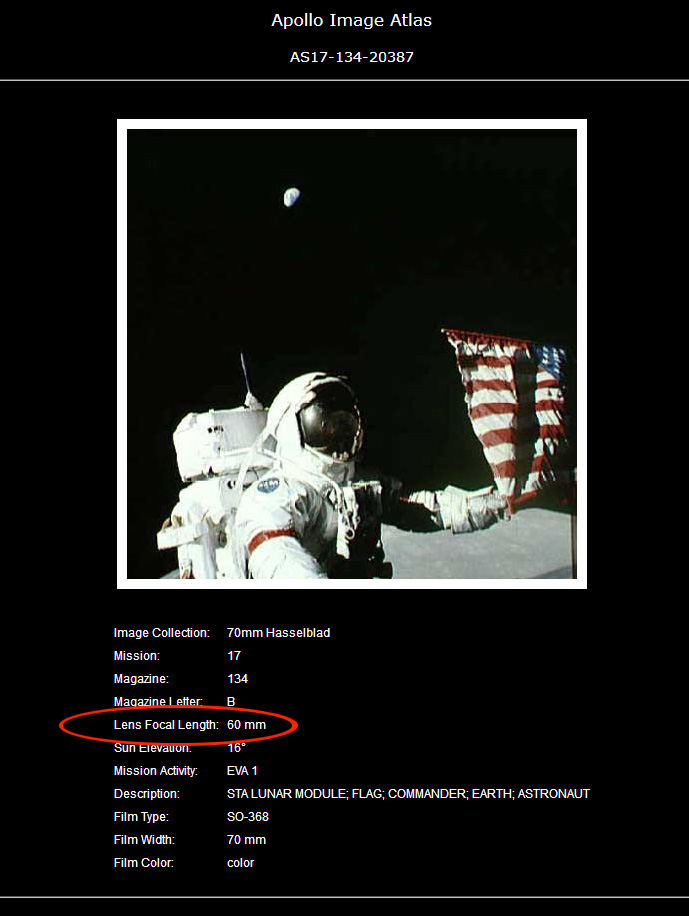
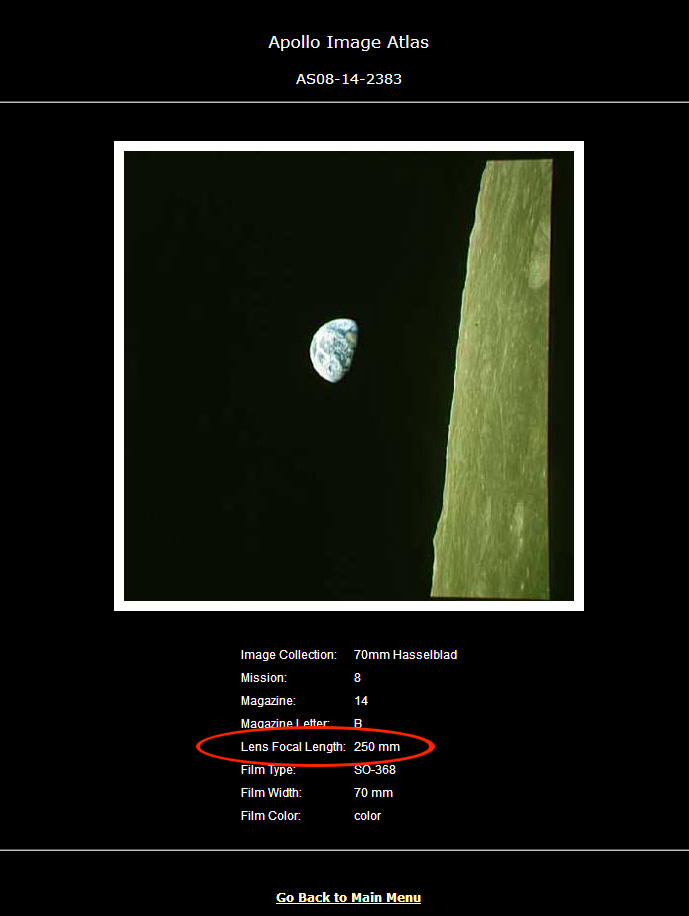
edit on 5/5/2017 by Soylent Green Is People because: (no reason given)
a reply to: PlasticDreams
First of all, human eyesight doesn't have a "zoom". You have an almost 180 degree view horizontally (fisheye) but your brain processes the information so that there are no distortions in what you see. But that's beside the point. The important bit is that the centre of your view has greater resolution than the preriphery, hence the ability to see good detail in what you're looking at directly (peripheral vision is better at detecting faint light and movement).
So, when looking at the Moon, it's no wonder that you can see quite a bit of detail on it, despite the Moon taking up just half a degree in your almost-180-degree field of view.
But it's best not to try to compare how cameras and lens work with how human eyesight works. With cameras and lens, you have straightforward maths showing how big subjects will appear both in the background and the foreground, etc. That's what we've been talking about in this thread.
To recap, the main factors are:
#1 Focal length
#2 Sensor (or film) size
#3 Distance to the subject.
And, to address your other concern, the Earth in that 60mm Apollo photo looks quite small because the film format is quite big: 70mm film, which is twice the size of the standard 35mm film. This makes the relative size of Earth in the frame smaller.
Conversely, most modern DSLRs have a sensor that is smaller than 35mm, resulting in a virtual zoom (and thus larger than usual subjects).
First of all, human eyesight doesn't have a "zoom". You have an almost 180 degree view horizontally (fisheye) but your brain processes the information so that there are no distortions in what you see. But that's beside the point. The important bit is that the centre of your view has greater resolution than the preriphery, hence the ability to see good detail in what you're looking at directly (peripheral vision is better at detecting faint light and movement).
So, when looking at the Moon, it's no wonder that you can see quite a bit of detail on it, despite the Moon taking up just half a degree in your almost-180-degree field of view.
But it's best not to try to compare how cameras and lens work with how human eyesight works. With cameras and lens, you have straightforward maths showing how big subjects will appear both in the background and the foreground, etc. That's what we've been talking about in this thread.
To recap, the main factors are:
#1 Focal length
#2 Sensor (or film) size
#3 Distance to the subject.
And, to address your other concern, the Earth in that 60mm Apollo photo looks quite small because the film format is quite big: 70mm film, which is twice the size of the standard 35mm film. This makes the relative size of Earth in the frame smaller.
Conversely, most modern DSLRs have a sensor that is smaller than 35mm, resulting in a virtual zoom (and thus larger than usual subjects).
edit
on 5-5-2017 by wildespace because: (no reason given)
a reply to: Soylent Green Is People
I know, but I wasn't contesting that, it is correct. This is my point,
The Moon, which is 1/4 the diameter of the Earth, viewed from Earth with a lens in the 60 mm range,
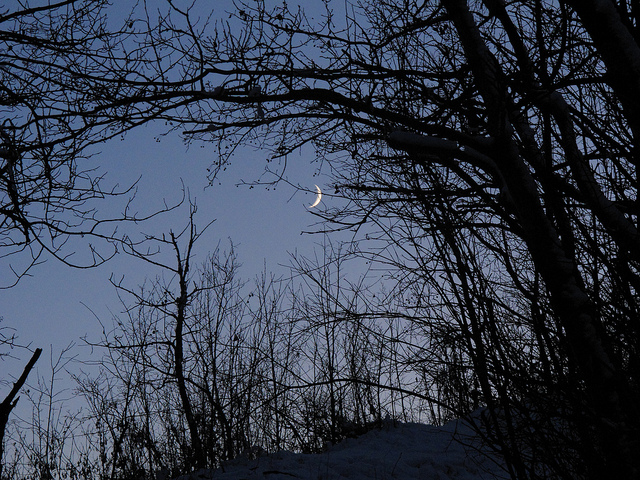
Earth, which is four times the diameter of the moon, viewed from the moon with a 60mm focal length lens,
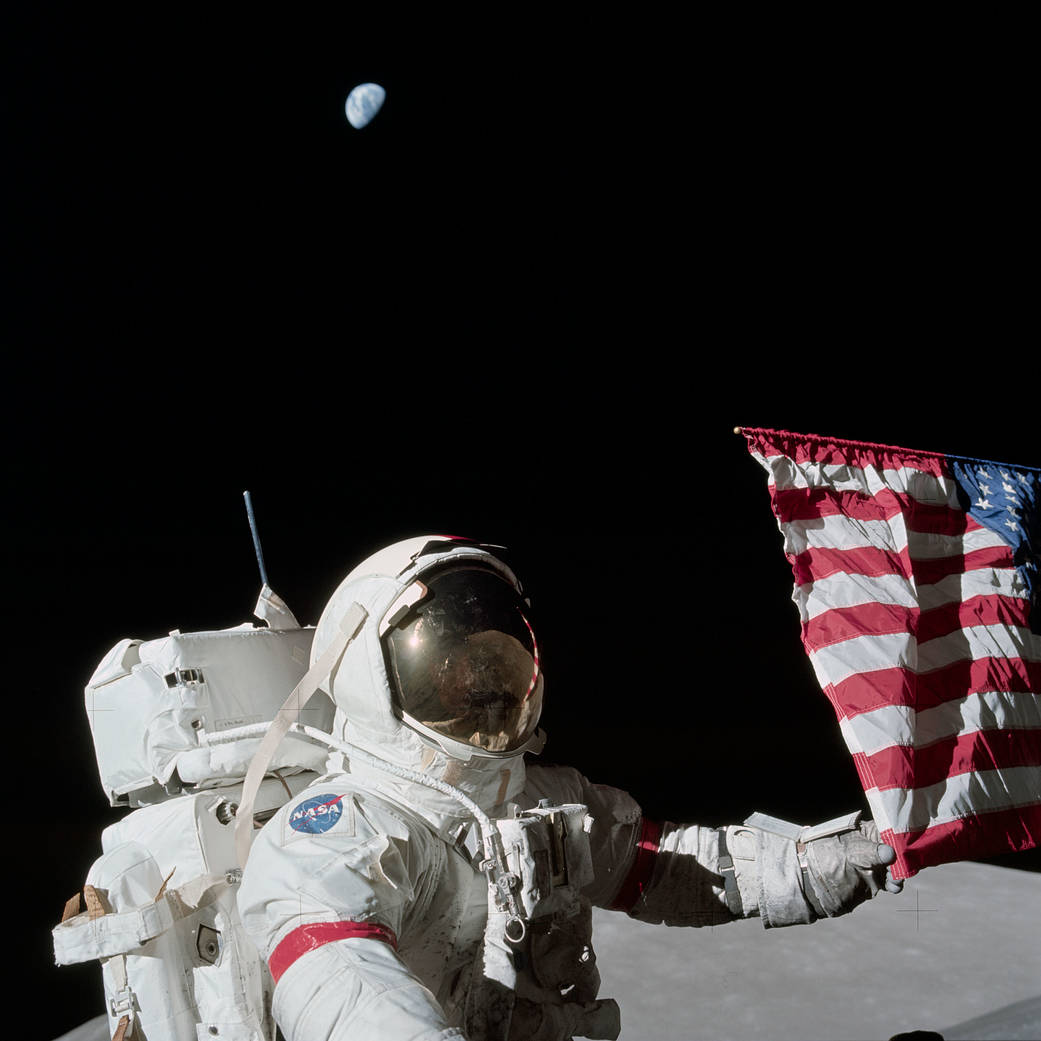
Now, as wildespace pointed out the film format in relation to focal length matters too, but it seemed to me that with this taken into account it still doesn't cancel out the fact that the Earth is four times bigger while looking about the same size from both viewpoints.
In the meantime, the OP's issue I was addressing was that the Moon looks to be different sizes in these two Apollo images because of the item I circles in red in each of the image descriptions:
I know, but I wasn't contesting that, it is correct. This is my point,
The Moon, which is 1/4 the diameter of the Earth, viewed from Earth with a lens in the 60 mm range,

Earth, which is four times the diameter of the moon, viewed from the moon with a 60mm focal length lens,

Now, as wildespace pointed out the film format in relation to focal length matters too, but it seemed to me that with this taken into account it still doesn't cancel out the fact that the Earth is four times bigger while looking about the same size from both viewpoints.
edit on 5-5-2017 by PlasticDreams because: (no reason given)
a reply to: PlasticDreams
What is the exif data for the Moon image through the trees ie focal length and actual camera model.
As for wildspace comments I posted that info on page 4 with images for relative size of film formats & sensors.
What is the exif data for the Moon image through the trees ie focal length and actual camera model.
As for wildspace comments I posted that info on page 4 with images for relative size of film formats & sensors.
originally posted by: PlasticDreams
a reply to: Soylent Green Is People
Now, as wildespace pointed out the film format in relation to focal length matters too, but it seemed to me that with this taken into account it still doesn't cancel out the fact that the Earth is four times bigger while looking about the same size from both viewpoints.
The difference in film format is quite big here. 70mm is about twice as wide as 35mm and is even larger vertically. Modern consumer cameras use a sensor smaller than 35mm, resulting in an even bigger difference between them and the Apollo images.
Here's what that Apollo image would have looked like with the same lens but 35mm film (looking at Earth)
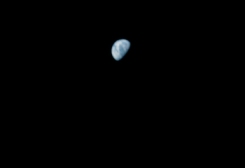
You can see that the Earth is taking quite a bit of the frame space, and thus would look fairly large in the photo.
Now, the original 70mm image itself, at the same scale:

edit on 6-5-2017 by wildespace because: (no reason given)
I'll try another version of this just to try and make the point again. I've superimposed the Apollo image on top of the Stellarium projection of the
lunar sky from Taurus-Littrow. The Stellarium projection has curved the panoramic image and is a photo series taken some distance from the actual
landing site (so Earth is in a slightly different place as a result of parallax).


Let's try another angle. This video
shows the Apollo 17 crew at Tracey's rock (geology station 6). While they were there the camera mounted on the rover zooms around and finally finds Earth (a meteorologically and configurationally accurate Earth I might add). By taking successive screengrabs of the pans we can compose a view showing the mountain in the background and the Earth:

Right place, right size.
shows the Apollo 17 crew at Tracey's rock (geology station 6). While they were there the camera mounted on the rover zooms around and finally finds Earth (a meteorologically and configurationally accurate Earth I might add). By taking successive screengrabs of the pans we can compose a view showing the mountain in the background and the Earth:

Right place, right size.
edit on 6/5/2017 by OneBigMonkeyToo because: tyop
And another from the Apollo 17 EVA live broadcasts, this time from station 2 at Nansen crater, at the base of the south Massif (at 04:39:33).
this is a composite view that I put together from successive screen grabs as the LRV camera panned around.

The location is the same as where they took this image (AS17-137-20910):

You can see the rock featured in that image between the LRV hardware in the centre of my composite.
As an aside, it's again worth noting the different apparent location of Earth relative to the south massif summit plateau, which is an indication that the Earth is not on some painted backdrop but is much further away than the horizon.
this is a composite view that I put together from successive screen grabs as the LRV camera panned around.

The location is the same as where they took this image (AS17-137-20910):

You can see the rock featured in that image between the LRV hardware in the centre of my composite.
As an aside, it's again worth noting the different apparent location of Earth relative to the south massif summit plateau, which is an indication that the Earth is not on some painted backdrop but is much further away than the horizon.
edit on 6/5/2017 by OneBigMonkeyToo because: time
added
new topics
-
Who guards the guards
US Political Madness: 6 minutes ago -
Has Tesla manipulated data logs to cover up auto pilot crash?
Automotive Discussion: 1 hours ago -
whistleblower Captain Bill Uhouse on the Kingman UFO recovery
Aliens and UFOs: 6 hours ago -
1980s Arcade
General Chit Chat: 9 hours ago -
Deadpool and Wolverine
Movies: 9 hours ago -
Teenager makes chess history becoming the youngest challenger for the world championship crown
Other Current Events: 10 hours ago -
CIA botched its handling of sexual assault allegations, House intel report says
Breaking Alternative News: 11 hours ago
top topics
-
Lawsuit Seeks to ‘Ban the Jab’ in Florida
Diseases and Pandemics: 14 hours ago, 20 flags -
Starburst galaxy M82 - Webb Vs Hubble
Space Exploration: 16 hours ago, 13 flags -
CIA botched its handling of sexual assault allegations, House intel report says
Breaking Alternative News: 11 hours ago, 8 flags -
15 Unhealthiest Sodas On The Market
Health & Wellness: 16 hours ago, 6 flags -
whistleblower Captain Bill Uhouse on the Kingman UFO recovery
Aliens and UFOs: 6 hours ago, 6 flags -
1980s Arcade
General Chit Chat: 9 hours ago, 4 flags -
Deadpool and Wolverine
Movies: 9 hours ago, 3 flags -
Teenager makes chess history becoming the youngest challenger for the world championship crown
Other Current Events: 10 hours ago, 3 flags -
Has Tesla manipulated data logs to cover up auto pilot crash?
Automotive Discussion: 1 hours ago, 0 flags -
Who guards the guards
US Political Madness: 6 minutes ago, 0 flags
active topics
-
Who guards the guards
US Political Madness • 0 • : annonentity -
Man possibly killed by werewolf in Texas
Cryptozoology • 27 • : burritocat -
Candidate TRUMP Now Has Crazy Judge JUAN MERCHAN After Him - The Stormy Daniels Hush-Money Case.
Political Conspiracies • 620 • : Threadbarer -
Starburst galaxy M82 - Webb Vs Hubble
Space Exploration • 5 • : Justoneman -
whistleblower Captain Bill Uhouse on the Kingman UFO recovery
Aliens and UFOs • 6 • : Ophiuchus1 -
Deadpool and Wolverine
Movies • 1 • : stosh64 -
Lawsuit Seeks to ‘Ban the Jab’ in Florida
Diseases and Pandemics • 23 • : burritocat -
Has Tesla manipulated data logs to cover up auto pilot crash?
Automotive Discussion • 1 • : andy06shake -
15 Unhealthiest Sodas On The Market
Health & Wellness • 36 • : tanstaafl -
My wife just had a very powerful prophetic dream - massive war in Israel...
The Gray Area • 12 • : SchrodingersRat
